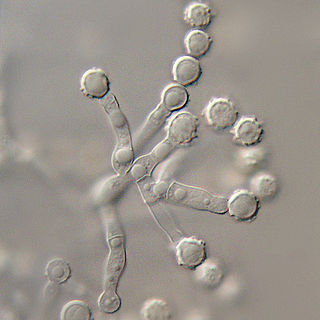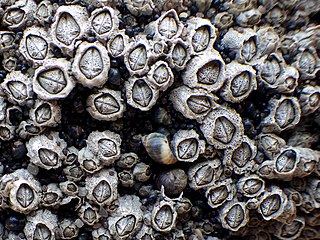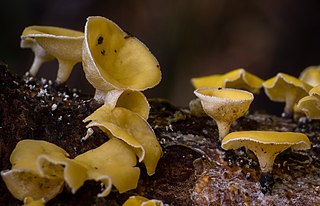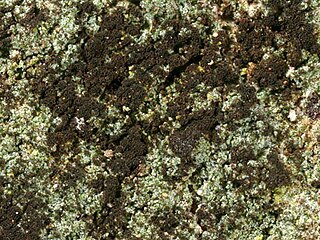Spegazzinia is a genus of widely distributed mitosporic ascomycete fungi in the family Didymosphaeriaceae.As accepted by Wijayawardene et al. 2020.

The Nectriaceae comprise a family of fungi in the order Hypocreales. It was circumscribed by brothers Charles and Louis René Tulasne in 1865. In 2020, an Outline of fungi was produced and listed 70 genera and about 1,336 species.

The Microascaceae are a family of fungi in the class Sordariomycetes, subclass Hypocreomycetidae. The family was published by David Malloch in 1970, an emended description based on Everet Stanley Luttrell's original 1951 publication. Family was updated in 2020.

Eutypa is a genus of fungi in the family Diatrypaceae. The widespread genus was estimated to contain 32 species in 2008, and then 68 by 2023. Anamorphic forms include the genera Libertella and Cytosporina. The genus was circumscribed in 1863 by the French mycologists and brothers Louis and Charles Tulasne.
Seynesia is a genus of fungi in the family Cainiaceae.
Parmularia is a genus of fungi in the family Parmulariaceae. The genus was circumscribed by Joseph-Henri Léveillé in 1846.

Xanthopyreniaceae is a family of lichen-forming fungi in the order Collemopsidiales. The family was circumscribed by lichenologist Alexander Zahlbruckner in 1926.

Massarina is a genus of fungi in the Massarinaceae family. Anamorph forms of species in Massarina include Acrocalymma, Ceratophoma, and Tetraploa. Massarina was circumscribed by Pier Andrea Saccardo in 1883. The widespread genus contains about 100 species.

Lachnellula is a genus of fungi in the family Lachnaceae. The genus contains 40 species. Lachnellula was circumscribed in 1884 by Petter Karsten, with Lachnellula chrysophthalma assigned as the type species.
The Apiosporaceae are a family of fungi in the Ascomycota. It was placed in the order Amphisphaeriales in 2020.
Trichosphaerella is a genus of lichenicolous fungi in the family Niessliaceae.

Bulgaria is a genus of fungi in the family Phacidiaceae. The genus was circumscribed in 1822 by Elias Magnus Fries, with Bulgaria inquinans assigned as the type species.

Ustilaginoidea is a genus of fungi in the family Clavicipitaceae. The genus contains 19 species. Ustilaginoidea was circumscribed by German botanist Julius Oscar Brefeld in 1895, with Ustilaginoidea oryzae assigned as the type species. Ustilaginoidea virens causes the disesase known alternatively as rice false smut, pseudosmut, or green smut.
Coniothyrium is a genus of fungi in the family Coniothyriaceae. The genus was circumscribed by Czech mycologist August Carl Joseph Corda in 1840. It was formerly placed in the Phaeosphaeriaceae family until 1983 when the family was established.
Harzia is a genus of seed-borne fungus that occurs in the soil. It has been categorized in the Ceratostomataceae family. The genus Harzia originally contained three accepted species: Harzia acremonioides, Harzia verrucose, and Harzia velatea. Within the genus Harzia, Harzia acremonioides is one of the most common species that can be found in all climate regions around the world.
Kabatiella is a genus of fungi belonging to the family Saccotheciaceae.
Volutella is a genus of fungi belonging to the family Nectriaceae.
Aposphaeria is a genus of fungi in the family Melanommataceae. The genus was circumscribed in 1880 by Pier Andrea Saccardo, with Aposphaeria pulviscula selected as the type species.

Stilbella is a genus of fungi in the order Hypocreales. The relationship of this taxon to other taxa within the order is unknown, and it has not yet been placed with certainty into any family. It is sometimes placed in the family Bionectriaceae.

Reichlingia is a genus of lichen-forming fungi in the family Arthoniaceae. It has seven species. The genus was originally circumscribed by Paul Diederich and Christoph Scheidegger in 1996, with Reichlingia leopoldii as the type, and at that time, only species. The fungus was at first thought to be a lichenicolous (lichen-dwelling) fungus, but is now considered a lichenised hyphomycete.









